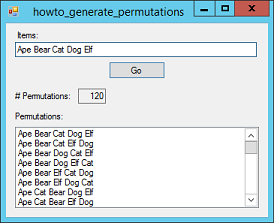
Title: Generate all of the permutations of a set of objects in C#

The basic idea is to use a recursive method to assign the next item in a permutation. The first call to the method assigns the permutation's first item, the next call assigns the second item, and so forth.
To assign an item, the method loops through all of the objects looking for those that have not already been assigned. When it finds such an item, the method:
- Adds the item to the current permutation.
- Marks the item as used in the current permutation.
- Recursively calls itself to assign the next item in the current permutation.
- When the recursive call returns, the method unmarks the item so it is not used and can be used again later.
The methods used by this program are generic. In this example, they use strings because strings are easy to enter on the form, but you can use the same methods to permute other kinds of objects.
The following code shows how the program generates permutations when you click the Go button.
// Generate the combinations.
private void btnGo_Click(object sender, EventArgs e)
{
// Get the items.
string[] items = txtItems.Text.Split(' ');
// Generate the permutations.
List<List<string>> results =
GeneratePermutations<string>(items.ToList());
// Display the results.
lstPermutations.Items.Clear();
foreach (List<string> combination in results)
{
lstPermutations.Items.Add(string.Join(" ",
combination.ToArray()));
}
// Calculate the number of permutations.
long num_permutations = Factorial(items.Length);
txtNumPermutations.Text = num_permutations.ToString();
// Check the result.
Debug.Assert(lstPermutations.Items.Count == num_permutations);
}
This code makes a list of the words you entered. It calls the GeneratePermutations method to build the permutations and then displays the results.
The following GeneratePermutations method really just sets up and then calls PermuteItems to do the real work.
// Generate permutations.
private List<List<T>> GeneratePermutations<T>(List<T> items)
{
// Make an array to hold the
// permutation we are building.
T[] current_permutation = new T[items.Count];
// Make an array to tell whether
// an item is in the current selection.
bool[] in_selection = new bool[items.Count];
// Make a result list.
List<List<T>> results = new List<List<T>>();
// Build the combinations recursively.
PermuteItems<T>(items, in_selection,
current_permutation, results, 0);
// Return the results.
return results;
}
This method creates an array to hold the current permutation and an array of flags to indicate which items are in the current permutation. It then calls the PermuteItems method, telling it to assign the first item. The PermuteItems method, which is shown in the following code, does all of the interesting work.
// Recursively permute the items that are
// not yet in the current selection.
private void PermuteItems<T>(List<T> items, bool[] in_selection,
T[] current_permutation, List<List<T>> results,
int next_position)
{
// See if all of the positions are filled.
if (next_position == items.Count)
{
// All of the positioned are filled.
// Save this permutation.
results.Add(current_permutation.ToList());
}
else
{
// Try options for the next position.
for (int i = 0; i < items.Count; i++)
{
if (!in_selection[i])
{
// Add this item to the current permutation.
in_selection[i] = true;
current_permutation[next_position] = items[i];
// Recursively fill the remaining positions.
PermuteItems<T>(items, in_selection,
current_permutation, results,
next_position + 1);
// Remove the item from the current permutation.
in_selection[i] = false;
}
}
}
}
This method first checks whether the current permutation is full. If so, it adds the current permutation to the results list and returns.
If the current permutation is not full, the code loops through the items. When it finds an item that is not yet in the permutation, the method adds that item to the permutation and calls itself recursively to fill in the rest of the permutation. When the recursive call returns, the method unmarks the item it added and continues looping through the remaining items.
Download the example to experiment with it and to see additional details.
|
![[C# Helper]](../banner260x75.png)

![[Beginning Database Design Solutions, Second Edition]](db2_79x100.png)
![[Beginning Database Design Solutions, Second Edition]](db2_79x100.png)